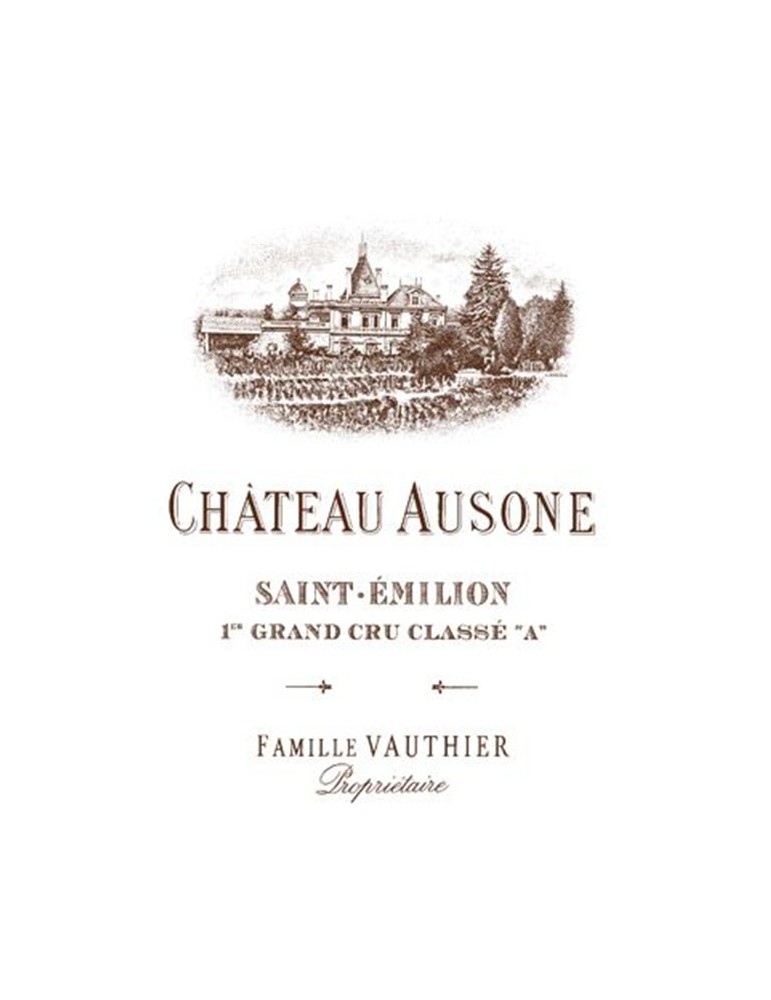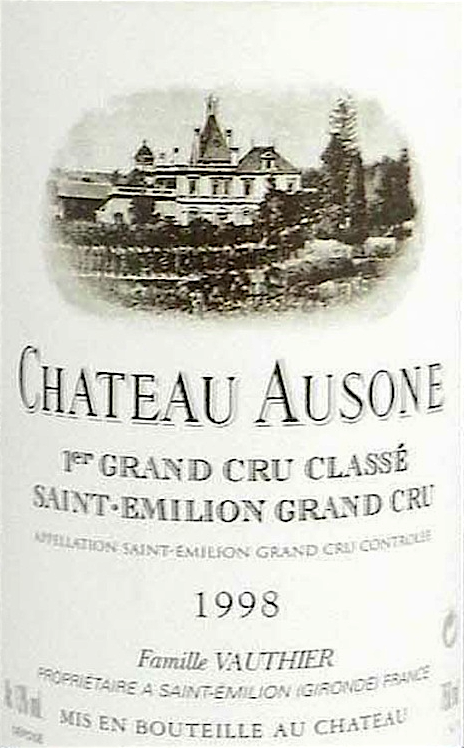
Château Ausone
33330 SAINT-EMILION
Tél. : +33 (0)5 57 24 24 57
Overlooking Saint-Emilion, high up on the highest-quality clay-limestone slopes in the Saint-Emilion appellation, Château Ausone is an emblematic 7-hectare estate that has embodied excellence and tradition in winegrowing for centuries, with discretion and humility despite its international renown.
Its history, through the name the estate bears, takes us back to Roman and Gallo-Roman times: the poet Ausonius, born in Bordeaux in the 4th century AD. It is said that he owned a villa on this site, as attested by the remains of the Gallo-Roman villa known as the Palat, discovered to the south of the estate. Over the centuries, the site has of course had many stories to tell, with numerous families occupying the land throughout the Middle Ages, including Les Lescours (13th and 16th centuries), Jacques de Lescure and his heirs (17th century), then the uninterrupted destiny of Pierre Chatonnet-Cantenat (from 1690), right up to his descendants, the present-day Vauthier family with the charismatic and very discreet Alain Vauthier. After some difficulties in the 70s and 80s, which could have jeopardized the quality of the wines - let's not forget the legal battle between the Dubois-Chalon family and the Vauthier family (co-owners of the estate) - Alain Vauthier, who had already been working on the estate since 1974, took over the reins of the château in the 90s, that is, in 1997. He currently runs the estate with his three children (Pauline, Edouard and Constance), representing the 11th generation of owners.
The family also owns the Saint-Emilion Grand Cru Classé, Château La Clotte (4 hectares acquired in 2014), Château Moulin Saint-Georges (8 hectares), Château Haut Simard (acquired in 2008), Château Simard and Château de Fonbel (in the Vauthier family since 1971).
Ausone, like the other illustrious Saint-Emilion, Château Cheval Blanc, occupies a special place, as attested by the ten-year classification of Saint-Emilion initiated in 1955 under the aegis of the INAO (Institut National des Appellations d'Origine Contrôlée), the Conseil des Vins de Saint-Emilion and validated by the French Ministry of Agriculture. Why this ranking? Quite simply, to be able to guarantee higher quality for consumers, and to act as a guideline for estates, encouraging them to constantly strive to improve the quality of their wines. Ausone didn't have to wait long in the 20th century to take center stage in the Olympus of Saint-Emilion grands crus. His place at the top of the podium was made official with the first edition of Saint-Emilion's ten-year classification in 1955, propelling Ausone into the "A" category of Premiers Crus Classés. Until 2011, there were only two Premiers Crus Classés "A" in this category: Château Ausone and Château Cheval Blanc, but since the 2012 classification update, they have been joined by Château Angélus and Château Pavie.The competition is healthy, and is being emulated.

Every wine should look like its birthplace (what we call typicity). At Ausone, we take care of our plots and terroir like gardeners, the latter being the hallmark of the inimitable style of every wine, and of Ausone in particular. Terroir infuses wines with minerality and tension (precision). It has to be said that the property is overlooked by a limestone heap. Limestone is everywhere. More than 7 centuries of limestone quarrying have shaped the local landscape. Here, as in all the subsoil of Saint-Emilion and even in the Fronsadais region, quarry workers were able to build the village and supply the famous white stone needed for urban development in Bordeaux. From this activity remain the clearly visible galleries (listed since 2015), a chapel of the Madeleine (listed), all serving as an ideal setting since the 17th century, to store the barrels and age the wines. The place is breathtaking and plunges visitors into another timeless dimension: sensation guaranteed!
On the vineyard side, it's all there: the beauty of the location, ideal east/south-east exposure and perfectly adapted grape varieties. 7 hectares stretch around the château and along the southern ramparts of the village of Saint-Emilion. Perfectly located atop the clay-limestone hillside and the famous asteriated limestone plateau so highly praised in Saint-Emilion and so recognized by the greatest specialists in Saint-Emilion wines, these vines carry all the promise of Cabernet Franc (55% of the vineyard, with the proportion tending to increase) and Merlot (45%).
In this privileged environment, the vineyards are protected from the wind, and the roots of the vines quickly come into contact with the porous limestone: a major advantage, allowing natural drainage (never excess water, even in the event of heavy rain) or gradual release of water during scorching summers. And the whole is not gelling. No wonder Ausone was able to preserve its vines, unlike others where over 80% of the vineyard was destroyed in the catastrophic frost of 1956. Thanks to this, Ausone can boast an average vine age in excess of 50 years, or even a century. This is another major advantage when you consider that old vines give the wine the most subtle expression of the local character.
At Ausone, we're much more of a gardener (upstream) than an interventionist in the vat room or cellar (downstream). This has always been the guiding and unifying principle in the Vauthier family's management of the vineyard. A great wine starts in the vineyard (common sense, as our elders would say, but many forget). So the focus turns to the grapes, which must be the purest and most ideally ripe, because here, the sublimation of fruit is king, as the wines attest. The vines are cultivated with precision and meticulousness, in accordance with the principles of organic farming. Everything is done by hand, with a vision of craftsmanship and precision. As for the vat room, there's nothing ostentatious about it, just enough to technically accompany the vatted vintage, reducing intervention as much as possible so as not to distort the expression of the terroir: proof that here, we remain first and foremost concerned with what nature generously offers when the year lends itself to it. Last but not least, the cellar is a singular sight: quarries and a chapel used as an ageing cellar. In a place conducive to prayer and quietude, each vintage patiently blossoms in ideal natural humidity and freshness. It's a reminder that wine can't be disturbed, and that you have to be patient with it (at least 10 years), or even deserve it.

Already acknowledged at the 1867 Universal Exhibition, where Saint-Emilion was actively promoted, Château Ausone wines are exceptional for their authenticity, elegance, depth and timelessness. Produced in relatively small quantities, around 20,000 bottles a year, its rarity in terms of volume and its reputation for quality explain its prices.
The wines on the first label, Château Ausone, express the precision and rigor of the Cabernet Franc in their early years, then let the fruit of the Merlot shine through. But the fruit flavors, guaranteed by healthy, ripe harvests and a fair proportion of new barrel ageing (when the vintage permits), are dazzling. The wine, rich in emotion, is powerful, mineral and seductive.With its density and ample yet delicate structure, this is a wine made for ageing. It's not surprising, then, that it should be kept for at least 10 to 15 years before its virtues are fully appreciated. Drinking Ausone is a truly unique experience.
The château also produces a second wine evoking the Chapelle de la Madeleine, a listed building on the estate. La Chapelle d'Ausone is the second label. Made from younger vines with a higher proportion of Merlot and Cabernet Sauvignon, this second wine is more accessible in terms of opening time, but is nonetheless a great wine. La Chapelle d'Ausone is the ideal gateway to the elegant, complex world of first wines.
1900-1906-1924-1928-1929-1945-1947-1949-1953-1955-1959-1961-1970-1975-1981-1982-1985-1988-1989-1990-1995-1998-2000-2005-2008-2009-2010-2015-2016-2018-2019-2020-2022

Website under construction
Available Soon